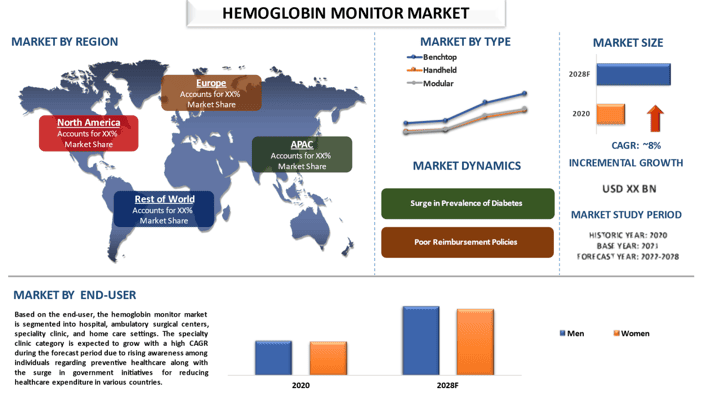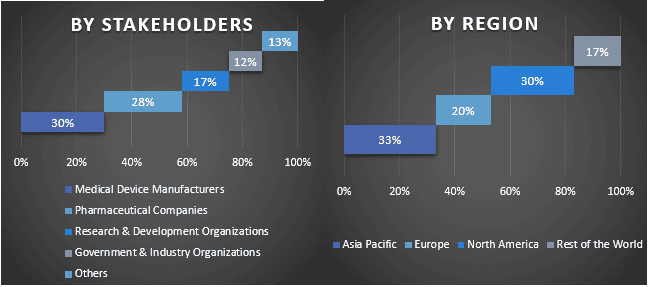
전 세계 헤모글로빈 모니터 시장은 예측 기간 동안 약 8%의 상당한 성장률을 보일 것으로 예상됩니다. 헤모글로빈 검사는 혈액 또는 적혈구(RBC) 수치 내 헤모글로빈의 양을 측정합니다. 적혈구에는 이산화탄소를 폐로 다시 운반하고 산소를 기관으로 운반하는 헤모글로빈이라는 종류의 단백질이 포함되어 있습니다. 의사는 심각한 질병을 앓고 있는 환자를 진단하거나 정기 검진의 일환으로 헤모글로빈 검사를 자주 사용합니다. 검사 결과 헤모글로빈 수치가 정상보다 낮으면 RBC 수치가 낮고 빈혈과 같은 질병의 위험이 있습니다. 주요 업체들은 시장에서 제품을 빠르게 출시하고 있으며 이는 예측 기간 동안 시장 성장에 긍정적인 영향을 미치고 있습니다. 예를 들어, 2018년 5월 Abbott은 미국에서 Afinion 2 분석기 출시를 발표했습니다. Afinion 2 분석기는 인체 혈액 내 헤모글로빈 A1c 판독을 단순화하고 간소화하여 진료 시 정확한 결과를 제공하는 소형 다중 분석, 고속 플랫폼입니다. 이러한 전략적 이니셔티브는 회사가 헤모글로빈 검사 장치 포트폴리오를 확장하는 데 도움이 되었습니다.
Masimo Corporation, Bayer AG, Siemens Healthineers, Welch Allyn, Inc., Koninklijke Philips N.V, Medtronic plc, Nihon Kohden Corporation, GE Healthcare, Smith’s Group 및 Omron Healthcare, Hill-Rom Holdings 등이 시장의 주요 업체입니다. 이러한 업체들은 고객에게 첨단 혁신적인 제품/기술을 제공하기 위해 여러 M&A와 파트너십을 체결했습니다.
보고서에 제시된 통찰력
“유형별로 태블릿 범주가 예측 기간 동안 더 높은 CAGR을 보일 것입니다.”
유형에 따라 시장은 휴대용, 탁상형 및 모듈형으로 분류됩니다. 휴대용 범주는 예측 기간 동안 높은 CAGR로 성장할 것으로 예상됩니다. 혈액 내 헤모글로빈의 양을 측정하는 휴대용 도구는 휴대용 헤모글로빈 모니터입니다. 휴대용 헤모글로빈 측정기에는 두 가지 범주가 있습니다. 한 종류의 휴대용 헤모글로빈 모니터는 손가락으로 찔러 혈액 샘플을 채취합니다. 다른 종류의 휴대용 헤모글로빈 모니터를 사용할 때는 손가락을 찌를 필요가 없습니다. 대신 피부에 빛을 비추어 혈액 내 헤모글로빈의 양을 측정합니다. 저렴한 가격과 관련된 장비의 용이성이 예측 기간 동안 부문별 성장을 주도하고 있습니다.
“최종 사용자 유형별로 병원이 2020년에 시장에서 상당한 점유율을 차지할 것입니다.”
최종 사용자 기준으로 헤모글로빈 모니터 시장은 병원, 외래 수술 센터, 전문 클리닉 및 가정 간호 환경으로 분류됩니다. 병원은 주로 심장 질환, 호흡기 질환 및 당뇨병과 같은 만성 질환의 발병률 증가로 인해 2020년에 시장에서 지배적인 점유율을 차지했으며 이는 헤모글로빈 측정이 필요한 혈액 검사에 대한 수요를 증가시킵니다.
“북미가 시장에서 상당한 점유율을 차지할 것입니다.”
2020년 북미는 전 세계 헤모글로빈 모니터 시장에서 상당한 점유율을 차지했습니다. 잘 확립된 의료 인프라의 존재, 이러한 장치가 제공하는 이점에 대한 인식 수준 증가, 유리한 정부 상환 정책은 큰 점유율에 기여하는 요인 중 일부입니다. 또한 암 및 당뇨병과 같은 만성 질환 사례가 증가함에 따라 혈액학 모니터링 장치를 포함한 고급 진단 절차에 대한 수요가 증가할 것으로 예상됩니다.
이 보고서를 구매해야 하는 이유:
- 이 연구에는 공인된 주요 산업 전문가가 검증한 시장 규모 및 예측 분석이 포함되어 있습니다.
- 이 보고서는 전체 산업 성과에 대한 빠른 검토를 한눈에 제공합니다.
- 이 보고서는 주요 비즈니스 재무, 제품 포트폴리오, 확장 전략 및 최근 개발에 중점을 둔 저명한 산업 동료에 대한 심층 분석을 다룹니다.
- 산업 전반에 걸쳐 만연한 동인, 제약, 주요 추세 및 기회에 대한 자세한 조사.
- 이 연구는 다양한 부문에 걸쳐 시장을 포괄적으로 다룹니다.
- 산업에 대한 심층적인 지역 수준 분석.
맞춤화 옵션:
전 세계 헤모글로빈 모니터 시장은 요구 사항 또는 기타 시장 부문에 따라 추가로 맞춤화할 수 있습니다. 이 외에도 UMI는 귀하가 자체적인 비즈니스 요구 사항을 가지고 있을 수 있음을 이해하므로 귀하의 요구 사항에 완전히 적합한 보고서를 얻기 위해 저희에게 연락하십시오.
목차
헤모글로빈 모니터 시장 분석 (2022-2028) 연구 방법론
글로벌 헤모글로빈 모니터 시장의 과거 시장 분석, 현재 시장 추정, 미래 시장 예측은 전 세계 주요 지역에서 헤모글로빈 모니터의 채택을 분석하고 예측하기 위해 수행된 세 가지 주요 단계였습니다. 과거 시장 수치를 수집하고 현재 시장 규모를 추정하기 위해 철저한 2차 연구가 수행되었습니다. 둘째, 이러한 통찰력을 검증하기 위해 수많은 결과와 가정이 고려되었습니다. 또한, 글로벌 헤모글로빈 모니터 시장의 가치 사슬 전반에 걸쳐 업계 전문가들과 심층적인 1차 인터뷰도 진행되었습니다. 1차 인터뷰를 통해 시장 수치를 가정하고 검증한 후, 전체 시장 규모를 예측하기 위해 하향식/상향식 접근 방식을 사용했습니다. 이후, 시장 세분화 및 데이터 삼각 측량 방법을 채택하여 산업 관련 세그먼트 및 하위 세그먼트의 시장 규모를 추정하고 분석했습니다. 자세한 방법론은 아래에 설명되어 있습니다.
과거 시장 규모 분석
1단계: 2차 자료 심층 연구:
연례 보고서 및 재무 제표, 성과 발표, 보도 자료 등과 같은 회사 내부 자료와 저널, 뉴스 및 기사, 정부 간행물, 경쟁사 간행물, 부문 보고서, 타사 데이터베이스 및 기타 신뢰할 수 있는 간행물을 포함한 외부 자료를 통해 헤모글로빈 모니터 시장의 과거 시장 규모를 파악하기 위해 자세한 2차 연구를 수행했습니다.
2단계: 시장 세분화:
헤모글로빈 모니터 시장의 과거 시장 규모를 파악한 후, 주요 지역의 다양한 세그먼트 및 하위 세그먼트에 대한 과거 시장 통찰력과 점유율을 수집하기 위해 자세한 2차 분석을 수행했습니다. 주요 세그먼트는 유형 및 최종 사용자로 보고서에 포함됩니다. 또한, 해당 지역에서 테스트 모델의 전반적인 채택을 평가하기 위해 국가별 분석을 수행했습니다.
3단계: 요인 분석:
다양한 세그먼트 및 하위 세그먼트의 과거 시장 규모를 확보한 후, 헤모글로빈 모니터 시장의 현재 시장 규모를 추정하기 위해 자세한 요인 분석을 수행했습니다. 또한, 다양한 유형 및 헤모글로빈 모니터 최종 사용자와 같은 종속 및 독립 변수를 사용하여 요인 분석을 수행했습니다. 전 세계 헤모글로빈 모니터 시장 부문에서 주요 파트너십, 합병 및 인수, 사업 확장 및 제품 출시를 고려하여 수요 및 공급 측면 시나리오에 대한 철저한 분석을 수행했습니다.
현재 시장 규모 추정 및 예측
현재 시장 규모 측정: 위 3단계의 실행 가능한 통찰력을 바탕으로 현재 시장 규모, 글로벌 헤모글로빈 모니터 시장의 주요 업체 및 세그먼트의 시장 점유율을 파악했습니다. 필요한 모든 백분율 점유율 분할 및 시장 세분화는 위에 언급된 2차 접근 방식을 사용하여 결정되었으며 1차 인터뷰를 통해 검증되었습니다.
추정 및 예측: 시장 추정 및 예측을 위해 동인 및 추세, 제약, 이해 관계자가 사용할 수 있는 기회를 포함한 다양한 요인에 가중치를 부여했습니다. 이러한 요인을 분석한 후, 관련 예측 기술, 즉 하향식/상향식 접근 방식을 적용하여 전 세계 주요 시장에서 다양한 세그먼트 및 하위 세그먼트에 대한 2028년 시장 예측을 도출했습니다. 시장 규모를 추정하기 위해 채택된 연구 방법론은 다음과 같습니다.
- 수익(USD) 측면에서 업계의 시장 규모와 국내 주요 시장에서 헤모글로빈 모니터 시장의 채택률
- 시장 세그먼트 및 하위 세그먼트의 모든 백분율 점유율, 분할 및 세분화
- 제공되는 제품 측면에서 글로벌 헤모글로빈 모니터 시장의 주요 업체. 또한 빠르게 성장하는 시장에서 경쟁하기 위해 이러한 업체가 채택한 성장 전략
시장 규모 및 점유율 검증
1차 연구: 주요 지역에서 최고 경영진(CXO/VP, 영업 책임자, 마케팅 책임자, 운영 책임자, 지역 책임자, 국가 책임자 등)을 포함한 주요 오피니언 리더(KOL)와 심층 인터뷰를 진행했습니다. 그런 다음 1차 연구 결과를 요약하고 명시된 가설을 입증하기 위해 통계 분석을 수행했습니다. 1차 연구의 입력 내용은 2차 결과와 통합되어 정보를 실행 가능한 통찰력으로 전환했습니다.
다양한 지역의 1차 참가자 분할

시장 엔지니어링
전반적인 시장 추정을 완료하고 글로벌 헤모글로빈 모니터 시장의 각 세그먼트 및 하위 세그먼트에 대한 정확한 통계 수치를 도출하기 위해 데이터 삼각 측량 기술을 사용했습니다. 글로벌 헤모글로빈 모니터 시장에서 제품 유형, 응용 분야, 질병 및 유통 채널 영역의 다양한 매개변수 및 추세를 연구한 후 데이터를 여러 세그먼트 및 하위 세그먼트로 분할했습니다.
글로벌 헤모글로빈 모니터 시장 연구의 주요 목표
글로벌 헤모글로빈 모니터 시장의 현재 및 미래 시장 동향은 연구에서 정확히 파악되었습니다. 투자자는 연구에서 수행된 질적 및 양적 분석에 따라 투자를 재량에 따라 결정하기 위한 전략적 통찰력을 얻을 수 있습니다. 현재 및 미래 시장 동향은 지역 수준에서 시장의 전반적인 매력도를 결정하여 산업 참가자가 미개척 시장을 활용하여 선점자 이점을 누릴 수 있는 플랫폼을 제공했습니다. 연구의 다른 양적 목표는 다음과 같습니다.
- 가치(USD) 측면에서 헤모글로빈 모니터 시장의 현재 및 예측 시장 규모를 분석합니다. 또한 다양한 세그먼트 및 하위 세그먼트의 현재 및 예측 시장 규모를 분석합니다.
- 연구의 세그먼트에는 유형 및 최종 사용자의 영역이 포함됩니다.
- 헤모글로빈 모니터 산업에 대한 규제 프레임워크를 정의하고 분석합니다.
- 다양한 중개인의 존재와 관련된 가치 사슬을 분석하고 산업의 고객 및 경쟁업체 행동을 분석합니다.
- 주요 지역에 대한 헤모글로빈 모니터 시장의 현재 및 예측 시장 규모를 분석합니다.
- 보고서에서 연구된 지역의 주요 국가에는 아시아 태평양, 유럽, 북미 및 기타 지역이 포함됩니다.
- 헤모글로빈 모니터 시장의 회사 프로필과 빠르게 성장하는 시장에서 생존하기 위해 시장 참여자가 채택한 성장 전략
산업에 대한 심층적인 지역 수준 분석
관련 보고서
이 상품을 구매한 고객님들도 함께 구매하신 상품










